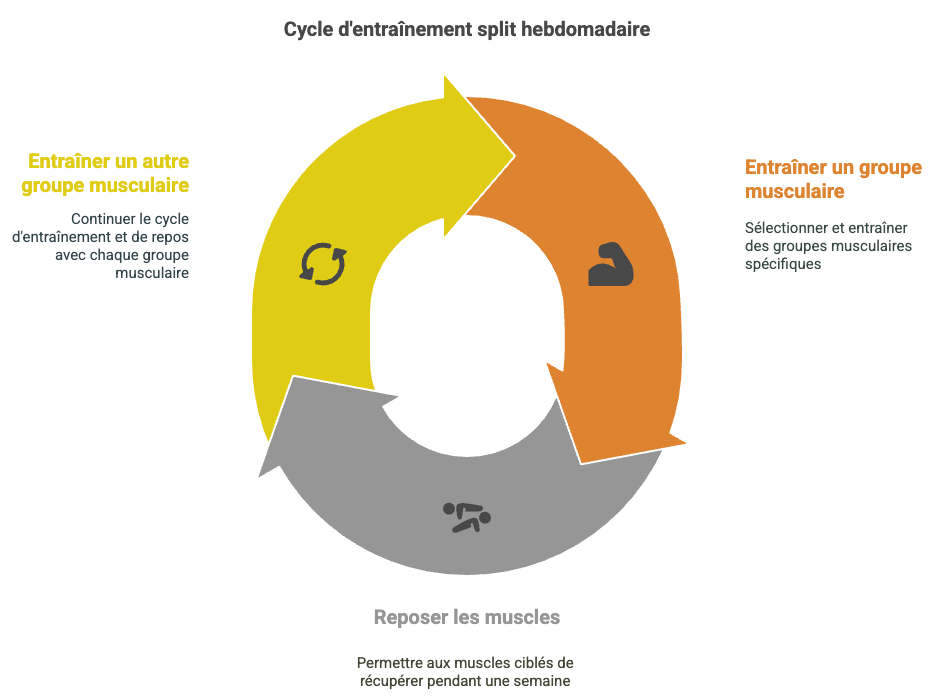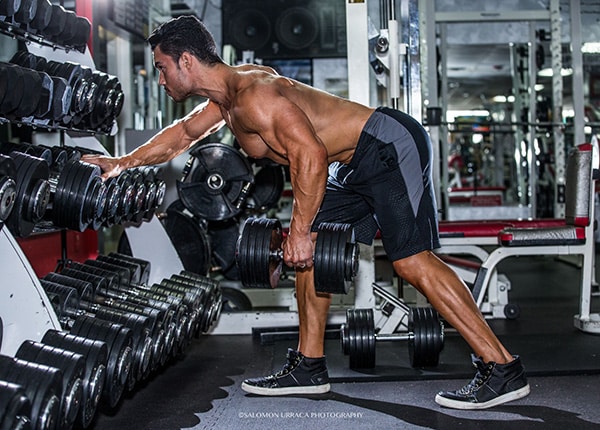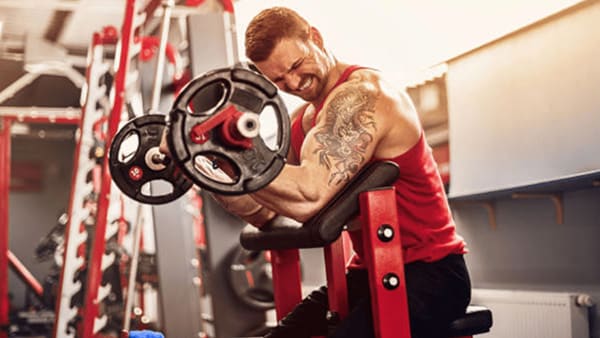Le programme split est un type d’entraînement que vous devez absolument connaître. Si vous êtes débutant et que vous avez opté pour du full body ou du half body, vous avez fait le bon choix.
Toutefois, après quelques mois de pratique, il sera certainement préférable de changer pour une split routine afin de poursuivre votre prise de muscle. Découvrez tout ce que vous devez savoir sur cette méthode, ainsi que plusieurs exemples de programmes.
La méthode split, en bref :
- Le programme split cible 1 ou 2 groupes musculaires par séance.
- Il est recommandé aux pratiquants ayant déjà plusieurs mois d’expérience.
- Contrairement au full body, le split optimise l’intensité et le volume d’entraînement par muscle.
- Passer au split est pertinent lorsque le full body ou le half body ne permettent plus de progresser.
- Cette méthode favorise la croissance en ciblant les muscles sous différents angles.
- Plusieurs formats possibles : split sur 3, 4 ou 5 jours par semaine.
Sommaire

La méthode split en musculation : de quoi s’agit-il ?
Le terme « split » est un mot anglais qui se traduit par « divisé » ou « séparé ».
Appliquée à l’univers de la muscu, cette notion est utilisée pour désigner une méthode d’entraînement.
Un programme split consiste à solliciter un ou deux groupes musculaires (parfois trois) seulement lors d’un seul et même entraînement de musculation.
Concrètement, pour une personne dont la pratique de la musculation s’articule autour de 4 séances par semaine, voici à quoi pourrait ressembler une routine split :
- Séance 1 (lundi) : pectoraux et triceps
- Séance 2 (mardi) : dos et biceps
- Séance 3 (jeudi) : jambes et abdominaux
- Séance 4 (vendredi) : épaules et trapèzes
Après chaque training, le groupe musculaire sollicité est mis au repos pendant une semaine complète. De cette manière, il peut récupérer de manière optimale.

Le programme split est l’une des méthodes de répartition d’entraînement les plus répandues chez les pratiquants intermédiaires et avancés. Ce type de plan est également reconnu dans la littérature scientifique comme étant efficace pour le développement de la masse musculaire.
Pour les débutants, les principes de ce programme de musculation par groupe musculaire s’avèrent être beaucoup trop intenses. En effet, un muscle est ciblé par plusieurs exercices de base et d’isolation lors d’une même séance d’entraînement.

Programme split vs programme full body ?
Il existe différentes approches en matière d’entraînement de fitness ou de musculation. Mais il n’en existe pas une meilleure que l’autre, car cela dépend de différents paramètres : l’expérience, l’objectif visé, le volume d’entraînement hebdomadaire, etc.
Un pratiquant novice aura naturellement tendance à choisir un programme full body, car cela s’adapte parfaitement à un rythme d’entraînement comprenant 2 à 3 workouts par semaine.
De même, c’est un excellent moyen de découvrir les différents exercices pour le haut et le bas du corps, et d’apprendre à maîtriser les techniques d’exécution.
En revanche, le full body présente un certain nombre de limites. D’une part, il n’est plus adapté si vous commencez à vous entraîner plus de 3 fois par semaine, car les muscles n’ont plus le temps de récupérer entre les séances.
D’autre part, l’enchaînement d’exercices cause de la fatigue, ce qui rend les fins d’entraînement moins efficaces.
Plusieurs études ont comparé les routines en split aux entraînements full-body. Une méta-analyse de Schoenfeld (2016) a montré que la fréquence d’entraînement joue un rôle important, mais que les méthodes peuvent être équivalentes si le volume hebdomadaire est maîtrisé

BOOSTEZ VOTRE TESTOSTÉRONE NATURELLEMENT
Mais alors, quand faut-il passer au split ?
Tout simplement lorsque votre programme full-body ou half-body ne vous permet plus de progresser et de gagner du muscle. Si vous stagnez depuis un certain temps sur des exercices tels que le développé couché, le soulevé de terre ou le squat, c’est certainement qu’il est temps de passer à un programme split.
Une autre alternative pourrait être de préférer le PPL, pour Push Pull Legs.
Est-ce que l’entraînement split est efficace ?
Cette méthode d’entraînement est aujourd’hui utilisée par l’immense majorité des pratiquants de musculation avancés et des bodybuilders. Cela s’explique par le fait qu’elle favorise grandement la croissance musculaire.
Plusieurs raisons peuvent l’expliquer.
Les avantages du programme split
En premier lieu, l’entraînement split permet de bien se focaliser sur chaque muscle, aussi bien au niveau des jambes que du haut du corps. Il est ainsi possible d’inclure des exercices d’isolation, d’alterner entre différents mouvements et de varier les prises pour recruter au mieux l’ensemble des fibres musculaires.
Par ailleurs, cette approche offre aussi la possibilité de se donner à 100 % durant chaque séance split. L’objectif du split, c’est de continuer jusqu’à la totale incapacité à poursuivre un exercice avec des mouvements corrects. On parle alors d’échec technique.
Mais en veillant à l’organisation et à la planification des trainings, ces échecs n’auront pas de répercussions préjudiciables sur la suite de l’entraînement ou du programme.
Vous pouvez ainsi placer les exercices polyarticulaires au début de la séance, puis les mouvements d’isolation à la fin. Chose qu’il n’est pas possible de faire avec une approche full body, dans laquelle les exercices de base se succèdent, causant une baisse d’intensité progressive.
Une fois tous les exercices effectués, vos muscles auront ensuite largement le temps de bien récupérer pour attaquer la séance de la semaine suivante.

Cette intensité favorise incontestablement l’augmentation du métabolisme. Il s’agit d’un avantage non négligeable si vous êtes dans une phase de perte de poids.
Enfin, une séance de musculation en split permet de travailler un groupe musculaire sous des angles très différents. Grâce à cette pratique, il est ainsi aisé de rectifier un déséquilibre ou un point faible au niveau de la silhouette. En effet, vous pouvez accentuer l’hypertrophie d’une partie de votre corps sous-développée.
En général, les parties les plus difficiles à muscler sont les mollets, les jambes et les avant-bras. Bien sûr, cela dépend de chaque personne.
Le split peut-il être responsable d’un surentraînement ?
Non, pas plus qu’une autre technique d’entraînement.
De multiples facteurs peuvent être à l’origine d’un surentraînement.
Mais concernant vos séances de musculation, si vous ne discutez pas et que vous respectez vos temps de repos, elles ne doivent pas durer plus d’une heure et demie (échauffement compris).
Comme nous l’avons vu, la méthode split offre suffisamment de temps pour récupérer avant la nouvelle série d’entraînement de la semaine suivante. La prise de masse musculaire est alors plus aisée, à condition d’être organisé et pragmatique dans la planification des séances et la répartition des exercices.
En revanche, il serait contre-productif de faire des séances trop longues, en pensant que plus vous travaillez un muscle, plus il grossira.
Les secrets d’un programme split réussi
Une bonne organisation d’ensemble
La planification des séances conditionne grandement la réussite d’un programme split. En effet, il est important de bien répartir les exercices à pratiquer au cours d’une semaine.
Il faut notamment tenir compte de l’intervention des muscles d’assistance. Même s’ils ne sont pas ciblés directement, ces derniers sont impliqués lorsque vous travaillez d’autres muscles. C’est, par exemple, le cas des épaules ou des triceps quand vous cherchez à développer vos pectoraux.
De même, un travail focalisé sur les tissus musculaires du dos ne peut se réaliser sans l’intervention des biceps et des deltoïdes postérieurs.
Si vous travaillez les pectoraux lors du premier entraînement de la semaine, il est donc déconseillé de faire un focus sur les épaules et les triceps dans les deux jours qui suivent. Vous devrez donc explorer d’autres possibilités, en ciblant les jambes, le dos ou les biceps.
Le travail des muscles d’assistance est un aspect souvent négligé par les pratiquants de musculation. Pourtant, il s’agit d’un facteur important pour prendre du muscle plus rapidement.

Naturellement, je vous recommande aussi de ne pas solliciter deux groupes musculaires importants (les jambes et les pectoraux, par exemple) lors du même entraînement, pour ne pas y laisser trop d’énergie.
Des jours de repos placés stratégiquement
Afin d’optimiser l’efficacité de vos exercices physiques, il est préférable de planifier vos jours de repos au lendemain des entraînements ciblant les tissus musculaires des jambes. En règle générale, les séances jambes laissent des traces, entre fatigue et courbatures.
Dans de telles circonstances, il devient plus difficile de soigner la technique d’exécution des mouvements, ce qui accroît le risque de blessure.
Toutefois, vous pouvez envisager d’effectuer une séance d’abdos ou de pratiquer une activité physique à faible intensité (marche, vélo, natation, etc.).

ATTEIGNEZ LE GRAAL DU 6 PACK !

ATTEIGNEZ LE GRAAL DU 6 PACK APRÈS 40 ANS !
L’échec technique plutôt que l’échec musculaire
À chaque exercice de musculation, il est primordial de travailler le plus intensément possible, parfois jusqu’à l’épuisement. C’est ce que l’on appelle l’échec musculaire.
Attention toutefois à privilégier l’exécution plutôt que les charges. Concrètement, quel que soit le nombre de répétitions effectué, considérez que vous êtes au bout de votre série à l’instant où vous sentez que votre technique se dégrade.
Cette astuce vous permettra de limiter le risque de vous blesser, ce qui freinerait considérablement votre progression. Rappelez-vous, pour atteindre vos objectifs en musculation, il est indispensable de s’inscrire dans la durée !
Exemples de programme de musculation en split
| Jours | Programme Split 3 Jours | Programme Split 4 Jours | Programme Split 5 Jours |
|---|---|---|---|
| Lundi | Pectoraux, Biceps, Abdominaux | Pectoraux et Triceps | Pectoraux |
| Mardi | Repos | Dos et Biceps | Dos |
| Mercredi | Quadriceps, Ischio-jambiers, Fessiers, Mollets | Repos | Jambes |
| Jeudi | Repos | Épaules, Trapèzes, Abdominaux | Biceps et Triceps |
| Vendredi | Dos, Épaules, Triceps | Jambes | Épaules, Trapèzes, Abdominaux |
| Samedi et dimanche | Repos | Repos | Repos |
Maintenant que vous savez tout de la méthode split, voyons 3 exemples de programmes basés sur cette approche :
- Un exemple de programme sur 3 jours d’entraînement par semaine
- Un exemple de programme sur 4 jours d’entraînement par semaine
- Un exemple de programme sur 5 jours d’entraînement par semaine
Bien sûr, chaque séance doit débuter par un bon échauffement musculaire et articulaire.
Exemple de programme split 3 jours
Séance 1 (lundi) : pectoraux, biceps et abdominaux
- Développé couché à la barre : 4 x 8 répétitions
- Développé incliné aux haltères : 4 x 8 répétitions
- Écartés à la poulie vis à vis : 4 x 12 répétitions
- Curl aux haltères : 4 x 10 répétitions
- Curl prise marteau : 4 x 10 répétitions
- Curl au pupitre : 4 x 8 répétitions
- Crunchs à la poulie : 4 x 15 répétitions
Séance 2 (mercredi) : quadriceps, ischio-jambiers, fessiers et mollets
- Squat : 5 x 8 répétitions
- Leg curl : 4 x 10 répétitions
- Leg extension : 4 x 12 répétitions
- Soulevé de terre jambes tendues : 4 x 8 répétitions
- Extensions mollets debout : 4 x 15 répétitions
- Extensions mollets assis : 4 x 15 répétitions
Séance 3 (vendredi) : dos, épaules et triceps
- Tirage vertical : 4 x 8 répétitions
- Tirage horizontal : 4 x 8 répétitions
- Développé militaire : 4 x 10 répétitions
- Rowing haltère : 4 x 10 répétitions
- Shrug : 3 x 12 répétitions
- Élévations latérales : 4 x 12 répétitions
- Barre au front : 4 x 12 répétitions
- Extensions à la poulie haute : 3 x 12 répétitions
Exemple de programme split 4 jours
Séance 1 (lundi) : pectoraux et triceps
- Développé couché à la barre : 4 x 8 répétitions
- Développé incliné aux haltères : 4 x 8 répétitions
- Écartés à la poulie vis à vis : 4 x 12 répétitions
- Barre au front : 4 x 12 répétitions
- Extensions à la poulie haute : 3 x 12 répétitions
- Pompes prise serrée : 4 x 15 répétitions
Séance 2 (mardi) : dos et biceps
- Tirage vertical : 4 x 8 répétitions
- Tirage horizontal : 4 x 8 répétitions
- Rowing haltère : 4 x 10 répétitions
- Curl aux haltères : 4 x 10 répétitions
- Curl prise marteau : 4 x 10 répétitions
- Curl au pupitre : 4 x 8 répétitions
- Tractions : 4 x 10 répétitions
Séance 3 (jeudi) : épaules, trapèzes et abdominaux
- Développé militaire : 4 x 10 répétitions
- Élévations latérales : 4 x 12 répétitions
- Élévations frontales : 4 x 12 répétitions
- Shrug : 4 x 12 répétitions
- Butterfly inversé : 4 x 10 répétitions
- Crunchs à la poulie : 4 x 15 répétitions
Séance 4 (vendredi) : jambes
- Squat : 4 x 8 répétitions
- Leg curl : 4 x 10 répétitions
- Leg extension : 4 x 12 répétitions
- Soulevé de terre jambes tendues : 4 x 8 répétitions
- Extensions mollets debout : 4 x 15 répétitions
- Extensions mollets assis : 4 x 15 répétitions
Exemple de programme split 5 jours
Séance 1 (lundi) : pectoraux
- Développé couché à la barre : 4 x 8 répétitions
- Développé incliné aux haltères : 4 x 8 répétitions
- Écartés à la poulie vis à vis : 4 x 12 répétitions
- Pull over : 4 x 10 répétitions
Séance 2 (mardi) : dos
- Tractions : 4 x 10 répétitions
- Rowing à la T-bar : 4 x 8 répétitions
- Tirage vertical : 4 x 8 répétitions
- Tirage horizontal : 4 x 8 répétitions
- Rowing haltère : 4 x 10 répétitions
Séance 3 (mercredi) : jambes
- Squat : 4 x 8 répétitions
- Leg curl : 4 x 10 répétitions
- Leg extension : 4 x 12 répétitions
- Soulevé de terre jambes tendues : 4 x 8 répétitions
- Extensions mollets debout : 4 x 15 répétitions
- Extensions mollets assis : 4 x 15 répétitions
Séance 4 (jeudi) : biceps et triceps
- Curl aux haltères : 4 x 10 répétitions
- Curl prise marteau : 4 x 10 répétitions
- Curl au pupitre : 4 x 8 répétitions
- Barre au front : 4 x 12 répétitions
- Extensions à la poulie haute : 3 x 12 répétitions
- Dips : 4 x 15 répétitions
Séance 5 (vendredi) : épaules, trapèzes et abdominaux
- Développé militaire : 4 x 10 répétitions
- Élévations latérales : 4 x 12 répétitions
- Élévations frontales : 4 x 12 répétitions
- Shrug : 4 x 12 répétitions
- Butterfly inversé : 4 x 10 répétitions
- Crunchs à la poulie : 4 x 15 répétitions
Conclusion
En musculation, le split est une méthode efficace pour continuer à progresser durablement. S’appuyant sur une planification réfléchie des entraînements, elle offre de multiples possibilités de personnalisation pour s’adapter à vos propres besoins.
FAQ
C’est un programme où l’on travaille un ou deux groupes musculaires différents à chaque séance.
Le full body entraîne tout le corps à chaque séance, idéal pour les débutants. Le split divise les muscles sur plusieurs jours pour une récupération optimale et un volume d’entraînement plus élevé.
Il faut répartir les groupes musculaires sur la semaine en évitant de solliciter les mêmes muscles ou muscles d’assistance deux jours de suite.
Passez au split lorsque vous vous entraînez plus de 3 fois par semaine et que votre progression en full body ralentit.
Un programme split peut être suivi sur 3, 4 ou 5 jours selon votre niveau et votre capacité de récupération.
Non, les débutants progressent mieux avec un programme full body ou half body avant de passer au split.
Oui, il permet de cibler chaque muscle avec plus d’intensité et favorise une meilleure hypertrophie musculaire.






